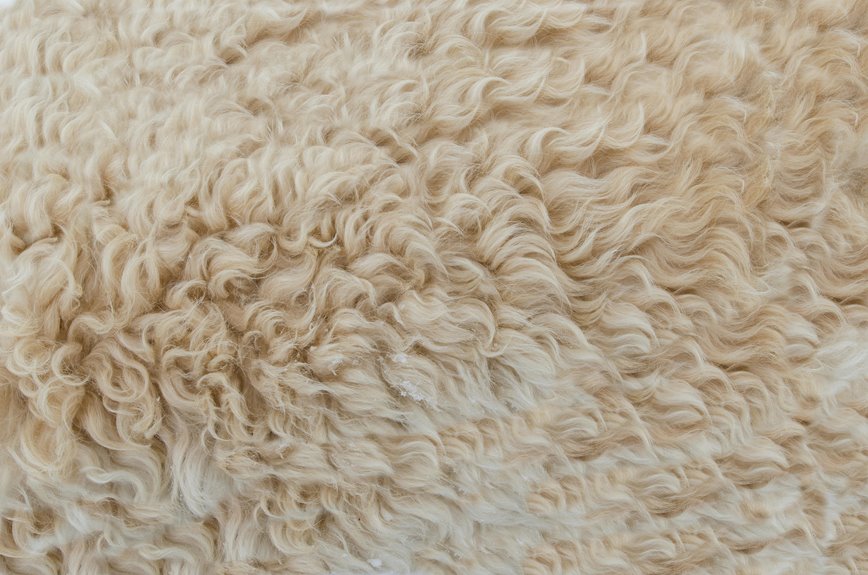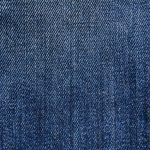You’ll find polyamide fabric smooth, lightweight, and slightly slick to the touch, offering a soft yet durable feel. It drapes well, stretches comfortably, and quickly wicks moisture away, keeping you dry during activity. While not as breathable as natural fibers like cotton or wool, it’s excellent for activewear because it resists wrinkles and wear. If you want to know how blends and specific uses affect its comfort and care, keep exploring the details.
Table of Contents
Key Takeaways
- Polyamide fabric has a smooth, slightly slick texture that feels lightweight against the skin.
- It offers a silky, second-skin sensation that reduces friction and irritation during wear.
- The fabric is breathable and efficiently wicks moisture, keeping skin cool and dry.
- Polyamide provides moderate softness but maintains durability over plush comfort.
- Its elasticity allows flexible, form-fitting comfort, ideal for active and everyday use.
The Basic Characteristics of Polyamide Fabric
Polyamide fabric stands out for its strength and durability, making it a popular choice in textiles. When you choose polyamide, you get a material that resists wear and tear better than many others.
It’s lightweight, which means it won’t weigh you down, and its elasticity lets it stretch without losing shape. Polyamide also dries quickly, so it’s ideal for activewear or outdoor gear.
You’ll find it resists wrinkles and holds color well, keeping garments looking fresh longer. Plus, it’s easy to clean and maintains its form after washing.
While it’s synthetic, polyamide blends well with other fibers, enhancing fabric performance. Knowing these basics helps you appreciate why polyamide remains a go-to fabric in many applications.
How Polyamide Feels Against the Skin
You’ll notice how smooth and lightweight this fabric feels when it touches your skin.
Polyamide drapes softly without feeling heavy or restrictive, making it comfortable for extended wear. It has a silky texture that glides gently over your body, reducing friction and irritation.
Because polyamide is breathable, it wicks moisture away efficiently, helping you stay dry and comfortable even during physical activity. You won’t feel the roughness common with some synthetic fabrics; instead, it offers a subtle stretch that moves with you naturally.
Polyamide breathes and wicks moisture, ensuring dryness and comfort with a gentle, natural stretch.
Whether in activewear or everyday clothing, polyamide adapts well to your movements, providing a sleek, second-skin sensation that keeps you feeling fresh and unrestricted throughout the day.
Comparing Polyamide to Natural Fabrics
When you compare polyamide to natural fabrics, you’ll notice clear differences in texture and breathability.
You’ll also want to weigh how each holds up in durability and softness over time.
Understanding these factors helps you choose the best fabric for your comfort needs.
Texture Differences
Although synthetic fibers often mimic natural ones, their texture can feel quite different to the touch. When you run your fingers over polyamide fabric, you’ll notice it’s smoother and sometimes slightly slick compared to the softness of cotton or the warmth of wool. Polyamide feels consistent and less prone to irregularities, making it ideal for activewear or outer layers.
Here’s a quick texture comparison:
| Fabric Type | Texture Feel |
|---|---|
| Polyamide | Smooth, slightly slick |
| Cotton | Soft, slightly rough |
| Wool | Coarse, warm, textured |
Understanding these differences helps you choose the right fabric for comfort and style based on your personal preference.
Breathability Comparison
Since breathability plays an essential role in comfort, understanding how polyamide compares to natural fabrics like cotton and wool can help you make better choices.
Polyamide is less breathable than natural fibers, which means it doesn’t allow air to flow through as easily. This can cause moisture to get trapped, making you feel warmer or sweaty during intense activities.
Natural fabrics like cotton and wool excel at wicking moisture and promoting airflow, keeping you cooler and drier.
Here’s a quick breathability comparison to evaluate:
- Cotton: Highly breathable and absorbs moisture well.
- Wool: Excellent at regulating temperature and wicking sweat.
- Polyamide: Durable and moisture-resistant but less ventilated.
Knowing these differences helps you pick the right fabric for your comfort needs.
Durability and Softness
While natural fabrics often feel softer against your skin, polyamide stands out for its remarkable durability and resilience. You’ll notice polyamide resists wear, tears, and stretching far better than cotton or wool, making it ideal for activewear or outer layers. However, its softness can feel slightly synthetic compared to the natural warmth and plushness of fabrics like cotton or silk. Here’s a quick comparison to help you understand:
| Feature | Polyamide |
|---|---|
| Durability | High – resists wear |
| Softness | Moderate – smooth but synthetic |
| Natural Fabric Durability | Moderate – prone to wear |
| Natural Fabric Softness | High – soft and breathable |
Choosing polyamide means prioritizing long-lasting wear with decent softness, while natural fabrics offer superior softness but less durability.
The Softness and Smoothness of Polyamide
Softness and smoothness define the tactile experience of polyamide fabric, making it a favorite for many who prioritize comfort.
When you touch polyamide, you’ll notice its silky surface that glides gently against your skin without irritation. This fabric feels light and supple, enhancing your overall wearing experience.
Here’s what you’ll appreciate about polyamide’s texture:
- Silky Finish: It has a sleek, almost glossy feel that adds a touch of luxury.
- Gentle Against Skin: You won’t experience itchiness or roughness.
- Flexible Texture: It moves with you, maintaining softness even after stretching.
This combination guarantees you feel comfortable and pampered every time you wear polyamide-based clothing.
Breathability and Moisture-Wicking Properties
You’ll notice that polyamide fabric allows good airflow, helping your skin stay cool and comfortable.
It efficiently manages sweat by wicking moisture away from your body. This keeps you dry even during intense activities.
Airflow and Ventilation
Because polyamide fabrics are designed to enhance airflow, they keep you comfortable by allowing heat and moisture to escape efficiently. When you wear polyamide, you’ll notice how it doesn’t trap heat like some other materials. This ventilation helps regulate your body temperature, making it ideal for activewear or warm weather.
Here’s what you can expect from polyamide’s airflow and ventilation:
- Lightweight, breathable structure that feels cool against your skin
- Quick-drying capability that prevents dampness buildup
- Mesh-like weaves in some polyamide blends that boost air circulation
These features work together so you stay fresh and dry, even during intense activity.
Polyamide’s ability to promote ventilation makes it a smart choice if you want fabric that adapts to your body’s needs.
Sweat Management Efficiency
While polyamide excels at ventilation, its sweat management efficiency truly sets it apart.
When you wear polyamide fabric, it actively pulls moisture away from your skin, keeping you dry and comfortable even during intense activities. This moisture-wicking property helps regulate your body temperature by allowing sweat to evaporate quickly, preventing that sticky, clammy feeling.
You’ll notice how the fabric’s breathability complements this function, promoting airflow that speeds up drying. Unlike some materials that trap moisture, polyamide guarantees you stay fresh and focused.
Whether you’re working out or simply going about your day, polyamide’s ability to manage sweat efficiently means you won’t have to worry about discomfort or irritation caused by dampness. This makes it an excellent choice for activewear and everyday clothing alike.
Stretch and Flexibility of Polyamide Materials
Although polyamide fabrics are known for their durability, they also offer impressive stretch and flexibility that adapt well to your movements. This makes polyamide ideal for activewear and everyday clothing where comfort and freedom are key.
Polyamide fabrics combine durability with stretch and flexibility, perfect for activewear and comfort-focused everyday clothing.
When you wear polyamide, you’ll notice it stretches smoothly without losing shape, giving you a second-skin feel. Its flexibility also helps reduce fabric bunching or restriction, so you can move naturally.
Here’s what you can expect from polyamide’s stretch and flexibility:
- Responsive elasticity: Moves with you during exercise or daily tasks
- Shape retention: Returns to its original form after stretching
- Comfortable fit: Adapts to different body shapes without feeling tight or loose
This combination guarantees you stay comfortable no matter how active you get.
The Impact of Fabric Blends on Polyamide Texture
When you mix polyamide with fibers like cotton or elastane, the texture changes noticeably.
These blends can make the fabric feel softer, stretchier, or more breathable depending on the combination.
Understanding these variations helps you choose the right blend for your comfort needs.
Common Blend Combinations
Because polyamide fibers naturally offer durability and smoothness, blending them with other fabrics can greatly alter their texture and comfort.
When you choose polyamide blends, you’ll find a variety of combinations designed to enhance certain qualities like breathability, softness, or stretch.
Here are some common blends to evaluate:
- Polyamide and Cotton: Adds softness and breathability while maintaining strength. You get a smoother, more natural feel.
- Polyamide and Elastane: Offers flexibility and stretch, making garments comfortable for active wear.
- Polyamide and Wool: Combines warmth and durability, giving a soft but resilient fabric ideal for cooler weather.
Texture Variations Explained
As you explore different blends, you’ll notice how each one changes the feel of polyamide fabric in unique ways.
When polyamide is mixed with cotton, it gains softness and breathability, making the fabric feel more natural against your skin.
Blends with elastane add stretchiness, giving you a flexible, snug fit without sacrificing smoothness.
Combining polyamide with wool introduces a slightly textured, cozy surface, which can feel warmer but still lightweight.
Silk blends elevate the fabric’s sheen and smoothness, creating a luxurious touch.
Each blend adjusts the polyamide’s inherent slickness and durability, so you can find a fabric that balances texture and function perfectly for your needs.
Understanding these variations helps you choose the right polyamide blend for your preferred tactile experience.
Comfort Differences Noted
Although polyamide alone offers durability and a smooth feel, blending it with other fibers markedly changes how comfortable the fabric feels against your skin.
When mixed with cotton, polyamide gains breathability and softness, making it ideal for everyday wear. Combining it with elastane adds stretch, enhancing flexibility and comfort during movement.
Meanwhile, blends with wool introduce warmth and a cozy texture, perfect for cooler climates. These blends affect not only comfort but also moisture management and durability.
Consider how you want your fabric to perform:
- Cotton-polyamide: soft, breathable, and easy on sensitive skin
- Polyamide-elastane: stretchy, form-fitting, and great for activewear
- Polyamide-wool: warm, insulating, yet still smooth to the touch
Choosing the right blend tailors comfort to your lifestyle.
Polyamide in Activewear: Comfort and Performance
When you choose polyamide for your activewear, you’re picking a fabric that balances durability with breathability.
Polyamide feels smooth against your skin, reducing irritation during intense workouts. Its moisture-wicking properties keep sweat away, helping you stay dry and comfortable.
Polyamide’s smooth, moisture-wicking fabric keeps you dry and irritation-free during every intense workout.
You’ll appreciate how lightweight polyamide stretches with your movements, offering excellent flexibility and support. This means you won’t feel restricted, whether you’re running, cycling, or practicing yoga.
The fabric also dries quickly, so you can shift from gym to daily activities without discomfort. Plus, polyamide maintains its shape well, ensuring your activewear fits perfectly over time.
When comfort and performance matter, polyamide makes your workout gear reliable and enjoyable to wear.
Durability and Resistance to Wear and Tear
If you want activewear that stands up to frequent use, polyamide delivers exceptional durability and resistance to wear and tear. You’ll appreciate how this fabric maintains its shape and strength, even after countless workouts and washes.
Polyamide’s resilience means it resists abrasions and tears better than many other materials, making it ideal for your most intense activities.
Here’s what you can expect from polyamide’s durability:
- Long-lasting fabric integrity that won’t easily stretch or sag
- Resistance to snagging and pilling, keeping your gear looking fresh
- Strong fiber composition that withstands friction and rough surfaces
With polyamide, you get activewear that works as hard as you do without falling apart.
Caring for Polyamide to Maintain Its Feel
To keep your polyamide activewear feeling soft and comfortable, you’ll need to follow proper care guidelines that preserve its texture.
Always wash polyamide garments in cold or lukewarm water using a gentle cycle to prevent fiber damage. Use mild detergents free from bleach or fabric softeners, as these can break down the fabric and reduce softness.
Avoid high heat when drying; instead, air dry your clothes flat or hang them up, steering clear of direct sunlight to prevent fading and stiffness. If you must use a dryer, select the lowest heat setting.
Ironing is usually unnecessary, but if needed, use a low temperature and place a cloth between the iron and fabric. Following these steps helps maintain polyamide’s smooth feel and extends its lifespan.
Frequently Asked Questions
Is Polyamide Fabric Environmentally Friendly?
You might find polyamide fabric less environmentally friendly since it’s a synthetic material derived from petroleum. However, some brands use recycled polyamide, so you can choose eco-conscious options that reduce environmental impact.
Can Polyamide Cause Allergic Reactions?
Yes, polyamide can cause allergic reactions if you have sensitive skin or a nylon allergy. You might experience itching or redness, so it’s best to test a small area before wearing it extensively.
How Does Polyamide Fabric Hold up in Extreme Weather?
Think of polyamide as a resilient shield; it holds up well in extreme weather by resisting moisture and drying quickly. You won’t feel weighed down, and it maintains durability, making it great for unpredictable conditions.
What Dyes Are Used for Coloring Polyamide?
You’ll find acid dyes and disperse dyes commonly used to color polyamide fabrics. They bond well with the fibers, giving you vibrant, long-lasting colors that resist fading even after multiple washes and wear.
Is Polyamide Fabric Recyclable?
You can recycle polyamide fabric, but it depends on local facilities and processes. Some recycling programs accept it, turning it into new fibers or products. Check with your local recycler to see if they handle polyamide materials.
- Where to Buy Sherpa Suede Fabric - July 12, 2025
- How to Draw or Illustrate the Texture of Suede Fabric - July 12, 2025
- What Is Baseball Suede Leather Fabric? - July 12, 2025







